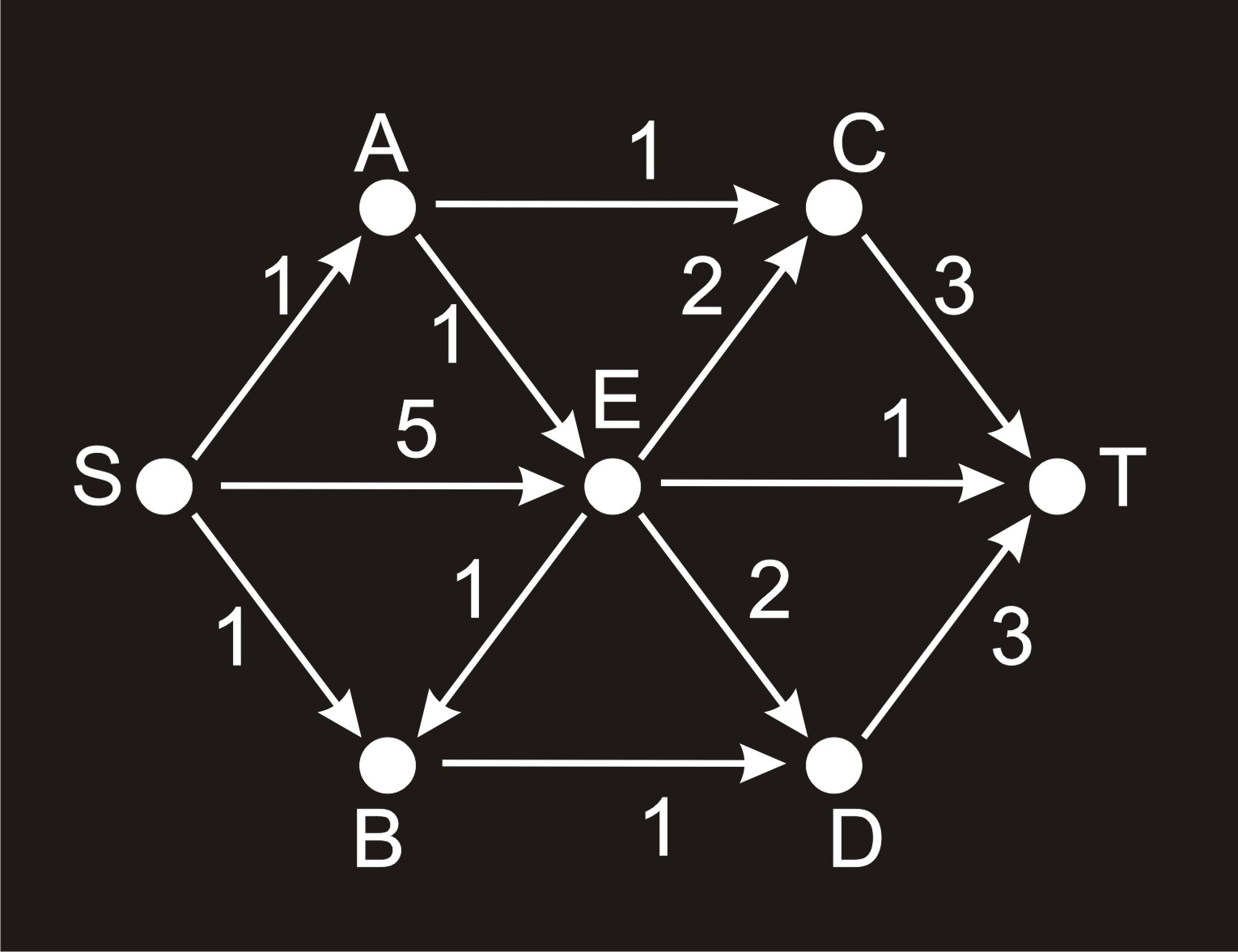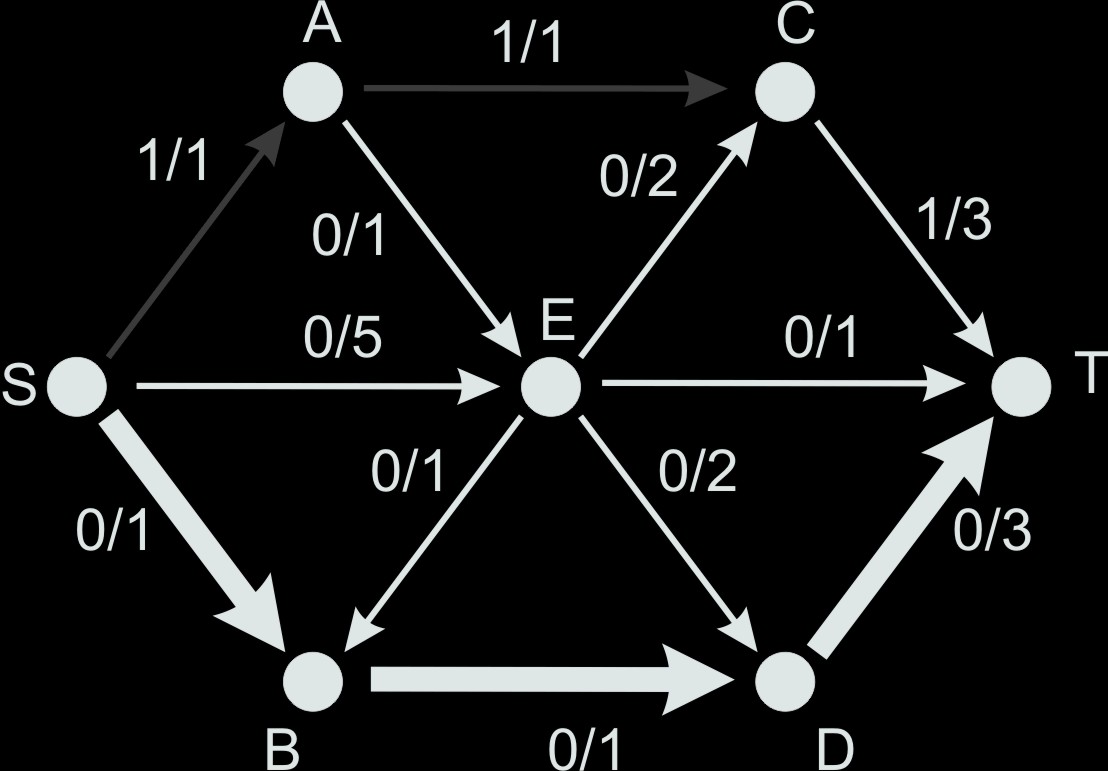Ford-Fulkerson algorithm
1. Original procedure of the algorithm
Ford-Fulkerson algorithm is used to find the maximum flow in a flow
network. We work with a network  ,
where
,
where  is a set of nodes
including a source
is a set of nodes
including a source  and sink
and sink  is a set of
directed edges.
A label of an edge is written as
is a set of
directed edges.
A label of an edge is written as  where
where  indicates its capacity
and
indicates its capacity
and  means a flow (amount of energy) streaming through the edge.
means a flow (amount of energy) streaming through the edge.
- At the beginning of the algorithm set the flow of all the edges to
 .
. - We repeatedly search for the augmenting path from the source
 to
the sink
to
the sink  .
As soon as we find such a path we also compute the available capacity
of all its edges, by which we subsequently increase the flow in the network.
.
As soon as we find such a path we also compute the available capacity
of all its edges, by which we subsequently increase the flow in the network.
When processing the algorithm in the standard way we work with a visual
representation of the network and modify labels of edges. Image 1
illustrates a network  with seven nodes and the current flow
with seven nodes and the current flow  (see the path
(see the path
 ). The augmenting path
). The augmenting path  ,
with the available capacity
,
with the available capacity  on all its edges is highlighted.
In the next step we can increase the flow and modify labels of
the augmenting path, change
on all its edges is highlighted.
In the next step we can increase the flow and modify labels of
the augmenting path, change  to
to  for the
paths
for the
paths  ,
,  and
and
 to
to  for the path
for the path  .
.
To demonstrate Ford-Fulkerson algorithm we come with an Animation 1 of the computation and use a concrete flow network.
Example 2: network 
-

- Start of the algorithm – a flow network
 with seven nodes
with seven nodes  ,
,  ,
,  ,
,  ,
,  ,
,  ,
, 
 :
:  –
– –
–
 –
– –
–
 –
– –
–
 :
:  –
– –
–
 –
– –
–
 :
:  –
– –
–
 :
:  –
– –
–
 :
:  –
– –
–
 :
:  –
– –
–
 –
– –
–
 –
– –
–
 –
– –
–
 Do not display this label
Do not display this label
2. Proposals of adaptation
1. Work with a network on a sheet of a spreadsheet editor:
The network is again converted to a table and organized
in a similar way as in the case of the first method
of Dijsktra's algorithm adaption.
We add labels of the nodes to the first column.
All the other cells on the row for a node  are reserved
for the edges coming out from
are reserved
for the edges coming out from  and are written as
and are written as
 –
– where
where  is the
end node of the edge,
is the
end node of the edge,  indicates the current flow through the edge and
indicates the current flow through the edge and  identifies
its capacity. Let us take the same network
identifies
its capacity. Let us take the same network  illustrated on the Image 1.
The following Table 1 demonstrates the situation after processing the first augmenting
path
illustrated on the Image 1.
The following Table 1 demonstrates the situation after processing the first augmenting
path 
Example 3: network 
A blind student finds an augmenting path from the source  to the sink
to the sink  .
He/she consecutively goes through the table and holds a sequence of the path's
nodes and actual available capacity of the path's edges in his/her memory.
During the second view he/she modifies
the flow and marks edges with the flow equal
to the capacity, which are directed from the source to the sink.
.
He/she consecutively goes through the table and holds a sequence of the path's
nodes and actual available capacity of the path's edges in his/her memory.
During the second view he/she modifies
the flow and marks edges with the flow equal
to the capacity, which are directed from the source to the sink.
2. Edges are organized one below each other on lines of a standard text editor:
every edge is written separately on one line
as  –
– –
– ,
where
,
where  is a starting node and
is a starting node and  is an ending
node of the edge with a capacity
is an ending
node of the edge with a capacity  and a current flow
and a current flow  .
The edges are ordered alphabetically according to the node
from which they come. We work in a similar way as when using
the previous method. We go through the table twice,
first to find an augmenting path from the source to the sink,
then to increase a flow on the path.
.
The edges are ordered alphabetically according to the node
from which they come. We work in a similar way as when using
the previous method. We go through the table twice,
first to find an augmenting path from the source to the sink,
then to increase a flow on the path.
3. Discussion of pros and cons
The first method was evaluated as the better one. It is easy to find the desired information in the table and to search for an augmenting path (Let us mention that it is difficult to find a maximum flow if we need to search for the augmenting path containing edges in the opposite direction.). When going through the graph using the second method a blind student has to observe many lines with data not relevant at the moment. We recommend students to make a note about the processed augmenting path in a temporary text file (it suffices to write down a sequence of nodes from the source to the sink).


 –
–
 –
–